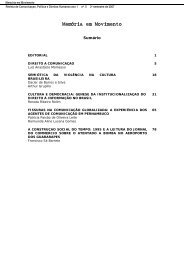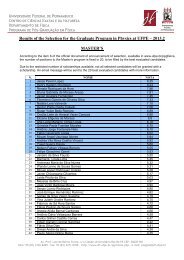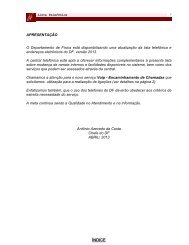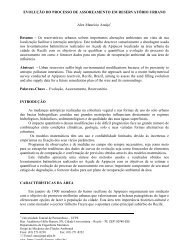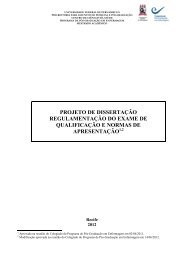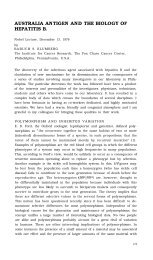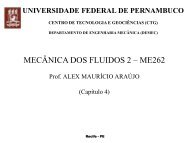- Page 1 and 2: Rules for the Classification of Shi
- Page 3 and 4: Definitions: "Rules" in these Gener
- Page 5 and 6: 1. Reference edition The reference
- Page 7: Chapters 1 2 3 4 5 6 7 8 9 10 11 12
- Page 10 and 11: Section 3 Documentation to be Submi
- Page 12 and 13: Section 3 Access Arrangement 1 Gene
- Page 14 and 15: 6 Icing 51 6.1 General 6.2 Icing ac
- Page 16 and 17: Section 3 Strength Principles 1 Gen
- Page 18 and 19: Section 6 Deck Structure 1 General
- Page 21: SECTION 1 APPLICATION SECTION 2 SYM
- Page 25 and 26: SECTION 2 SYMBOLS AND DEFINITIONS 1
- Page 27 and 28: 3.15 Type A and Type B ships 3.15.1
- Page 29 and 30: 2.3 Additional class notations 2.3.
- Page 31 and 32: Table 2 : Plans and documents to be
- Page 33 and 34: Pt B, Ch 1, Sec 3 Table 3 : Plans a
- Page 35 and 36: Part B Hull and Stability Chapter 2
- Page 37 and 38: SECTION 1 SUBDIVISION ARRANGEMENT 1
- Page 39 and 40: Watertight Below the freeboard deck
- Page 41 and 42: d) A double bottom need not be fitt
- Page 43 and 44: Pt B, Ch 2, Sec 2 Figure 1 : Credit
- Page 45 and 46: SECTION 3 ACCESS ARRANGEMENT 1 Gene
- Page 47: SECTION 1 GENERAL SECTION 2 INTACT
- Page 50 and 51: Pt B, Ch 3, Sec 1 3 Examination pro
- Page 52 and 53: Pt B, Ch 3, Sec 2 SECTION 2 INTACT
- Page 54 and 55: Pt B, Ch 3, Sec 2 Figure 1 : Severe
- Page 56 and 57: Pt B, Ch 3, Sec 2 4.5 Water ballast
- Page 58 and 59: Pt B, Ch 3, Sec 2 a) Slow accumulat
- Page 60 and 61: Pt B, Ch 3, App 1 1.1.4 Pendulums (
- Page 62 and 63: Pt B, Ch 3, App 1 The plotting of a
- Page 64 and 65: Pt B, Ch 3, App 2 APPENDIX 2 TRIM A
- Page 66 and 67: Pt B, Ch 3, App 2 allowed on the do
- Page 68 and 69: Pt B, Ch 3, App 2 Superstructures a
- Page 71 and 72: SECTION 1 MATERIALS 1 General 1.1 C
- Page 73 and 74:
Pt B, Ch 4, Sec 1 Table 4 : Minimum
- Page 75 and 76:
2.5.3 For the purpose of the select
- Page 77 and 78:
3.2.2 Rolled bars may be accepted i
- Page 79 and 80:
SECTION 2 NET SCANTLING APPROACH Sy
- Page 81 and 82:
3 Corrosion additions 3.1 Values of
- Page 83 and 84:
1.2 Connections with higher strengt
- Page 85 and 86:
The net section modulus of a built
- Page 87 and 88:
4.4.4 The width, in mm, of the face
- Page 89 and 90:
pS, pW : Still water and wave press
- Page 91 and 92:
4 Longitudinally framed double bott
- Page 93 and 94:
SECTION 5 SIDE STRUCTURE 1 General
- Page 95 and 96:
6.2.3 For connections of frames to
- Page 97 and 98:
SECTION 6 DECK STRUCTURE 1 General
- Page 99 and 100:
6.2 Corners of hatchways 6.2.1 For
- Page 101 and 102:
SECTION 7 BULKHEAD STRUCTURE 1 Gene
- Page 103 and 104:
3 Corrugated bulkheads 3.1 General
- Page 105 and 106:
Rules for the Classification of Shi
- Page 107 and 108:
Definitions: "Rules" in these Gener
- Page 109 and 110:
1. Reference edition The reference
- Page 111:
Chapters 1 2 3 4 5 6 7 8 9 10 11 12
- Page 114 and 115:
Section 3 Ship Motions and Accelera
- Page 116 and 117:
CHAPTER 6 HULL GIRDER STRENGTH Sect
- Page 118 and 119:
CHAPTER 7 HULL SCANTLINGS Section 1
- Page 120 and 121:
4 Yielding check of primary support
- Page 122 and 123:
Appendix 2 Analyses of Primary Supp
- Page 124 and 125:
CHAPTER 8 SHIPS LESS THAN 90 M IN L
- Page 126 and 127:
Section 4 Ordinary Stiffeners 1 Gen
- Page 129 and 130:
SECTION 1 GENERAL SECTION 2 HULL GI
- Page 131 and 132:
SECTION 1 GENERAL 1 Definitions 1.1
- Page 133 and 134:
2.5.3 Draught associated with each
- Page 135 and 136:
For all ships, the following loadin
- Page 137 and 138:
3.3 Wave torque 3.3.1 The wave torq
- Page 139 and 140:
4.2.2 Direct calculations As an alt
- Page 141 and 142:
δ : roll radius of gyration, in m,
- Page 143 and 144:
SECTION 4 LOAD CASES Symbols h1 : R
- Page 145 and 146:
Ship condition Load case Table 1 :
- Page 147 and 148:
Figure 2 : Wave pressure in load ca
- Page 149 and 150:
Table 5 : Wave pressure in inclined
- Page 151 and 152:
Figure 1 : Upright ship conditions
- Page 153 and 154:
Figure 4 : Breadth b S of the free
- Page 155 and 156:
Where the upper part of a longitudi
- Page 157 and 158:
4 Dry uniform cargoes 4.1 Still wat
- Page 159 and 160:
Pt B, Ch 5, App 1 APPENDIX 1 INERTI
- Page 161 and 162:
Part B Hull and Stability Chapter 6
- Page 163 and 164:
Pt B, Ch 6, Sec 1 SECTION 1 STRENGT
- Page 165 and 166:
G : Coulomb’s modulus, in N/mm2 ,
- Page 167 and 168:
where b, B 0 , A and 0 are the di
- Page 169 and 170:
2.4.2 Ships with two effective long
- Page 171 and 172:
zD : Z co-ordinate, in m, of the st
- Page 173 and 174:
APPENDIX 1 HULL GIRDER ULTIMATE STR
- Page 175 and 176:
1.2.2 Assumption In applying the pr
- Page 177:
1.3.7 Web local buckling of flat ba
- Page 180 and 181:
Symbols used in chapter 7 L1 , L2 :
- Page 182 and 183:
Pt B, Ch 7, Sec 1 2 General require
- Page 184 and 185:
Pt B, Ch 7, Sec 1 Table 4 : Combina
- Page 186 and 187:
Pt B, Ch 7, Sec 1 n : Number of whe
- Page 188 and 189:
Pt B, Ch 7, Sec 1 5.2.5 Combined in
- Page 190 and 191:
Pt B, Ch 7, Sec 1 τ E π2E 12 1 ν
- Page 192 and 193:
Pt B, Ch 7, Sec 2 SECTION 2 ORDINAR
- Page 194 and 195:
Pt B, Ch 7, Sec 2 Figure 3 : Net di
- Page 196 and 197:
Pt B, Ch 7, Sec 2 z ≥ N z < N Tab
- Page 198 and 199:
Pt B, Ch 7, Sec 2 Single wheel Doub
- Page 200 and 201:
Pt B, Ch 7, Sec 2 z ≥ N z < N 4 B
- Page 202 and 203:
Pt B, Ch 7, Sec 2 Figure 5 : Buckli
- Page 204 and 205:
Pt B, Ch 7, Sec 2 Symbol σ U f ζ
- Page 206 and 207:
Pt B, Ch 7, Sec 3 Table 1 : Primary
- Page 208 and 209:
Pt B, Ch 7, Sec 3 3.2 Bracket arran
- Page 210 and 211:
Pt B, Ch 7, Sec 3 where: Table 10 :
- Page 212 and 213:
Pt B, Ch 7, Sec 3 4.2 Analysis crit
- Page 214 and 215:
Pt B, Ch 7, Sec 3 Table 12 : Coeffi
- Page 216 and 217:
Pt B, Ch 7, Sec 4 SECTION 4 FATIGUE
- Page 218 and 219:
Pt B, Ch 7, Sec 4 Table 2 : Load ca
- Page 220 and 221:
Pt B, Ch 7, Sec 4 Axial misalignmen
- Page 222 and 223:
Pt B, Ch 7, Sec 4 Table 11 : Functi
- Page 224 and 225:
Pt B, Ch 7, App 1 APPENDIX 1 ANALYS
- Page 226 and 227:
Pt B, Ch 7, App 1 Figure 3 : Model
- Page 228 and 229:
Pt B, Ch 7, App 1 Figure 7 : Beams
- Page 230 and 231:
Pt B, Ch 7, App 1 Table 4 : Wave pr
- Page 232 and 233:
Pt B, Ch 7, App 1 Figure 9 : Refere
- Page 234 and 235:
Pt B, Ch 7, App 2 APPENDIX 2 ANALYS
- Page 236 and 237:
Pt B, Ch 7, App 2 Figure 1 : Spring
- Page 238 and 239:
Pt B, Ch 7, App 2 cargoes, these me
- Page 240 and 241:
Pt B, Ch 7, App 3 Table 1 : Areas t
- Page 242 and 243:
Pt B, Ch 7, App 3 3.2.2 Load effect
- Page 245 and 246:
SECTION 1 DESIGN LOADS Part B Hull
- Page 247 and 248:
SECTION 1 DESIGN LOADS Symbols For
- Page 249 and 250:
2.3 Vertical wave bending moments 2
- Page 251 and 252:
Table 7 : Coefficient for pressure
- Page 253 and 254:
5.8 Flooding Table 15 : Machinery S
- Page 255 and 256:
Figure 1 : Longitudinal girders bet
- Page 257 and 258:
σ 1S : Normal stress, in N/mm 2 ,
- Page 259 and 260:
SECTION 3 PLATING Symbols For symbo
- Page 261 and 262:
2.5.2 Rounded sheerstrake The net t
- Page 263 and 264:
γ t 14, 9cacrsγ S2pS + γW2pW = R
- Page 265 and 266:
where: σE : Euler buckling stress,
- Page 267 and 268:
SECTION 4 ORDINARY STIFFENERS Symbo
- Page 269 and 270:
where c T is a coefficient equal to
- Page 271 and 272:
Table 3 : Distribution factor F S H
- Page 273 and 274:
Configuration Single wheel Double w
- Page 275 and 276:
SECTION 5 PRIMARY SUPPORTING MEMBER
- Page 277 and 278:
Table 2 : Minimum net thicknesses o
- Page 279 and 280:
w γ γ S2λbSpS + γW2λ bWpW Rγ
- Page 281 and 282:
where: σ E3 : Euler local buckling
- Page 283 and 284:
Pt B, Ch 8, App 1 APPENDIX 1 SCANTL
- Page 285 and 286:
Table 2 : Scantlings of longitudina
- Page 287 and 288:
Element Formula Minimum value Inner
- Page 289 and 290:
Table 5 : Scantlings of side struct
- Page 291 and 292:
Table 7 : Scantlings of deck struct
- Page 293 and 294:
Type of ordinary stiffener Table 9
- Page 295 and 296:
Rules for the Classification of Shi
- Page 297 and 298:
Definitions: "Rules" in these Gener
- Page 299 and 300:
1. Reference edition The reference
- Page 301:
Chapters 1 2 3 4 5 6 7 8 9 10 11 12
- Page 304 and 305:
Section 2 Aft Part 1 General 29 1.1
- Page 306 and 307:
2.2 Inner doors 3 Scantlings of bow
- Page 308 and 309:
Section 8 Movable Decks and Inner R
- Page 310 and 311:
CHAPTER 10 HULL OUTFITTING Section
- Page 312 and 313:
Section 4 Equipment 1 General 113 1
- Page 314 and 315:
CHAPTER 12 CONSTRUCTION AND TESTING
- Page 317:
SECTION 1 FORE PART SECTION 2 AFT P
- Page 320 and 321:
Pt B, Ch 9, Sec 1 Table 1 : Fore pe
- Page 322 and 323:
Pt B, Ch 9, Sec 1 Table 7 : Longitu
- Page 324 and 325:
Pt B, Ch 9, Sec 1 C P = 1 for dP --
- Page 326 and 327:
Pt B, Ch 9, Sec 1 3.4 Scantlings 3.
- Page 328 and 329:
Pt B, Ch 9, Sec 1 5.1.2 Gross scant
- Page 330 and 331:
Pt B, Ch 9, Sec 2 Table 1 : Aft pea
- Page 332 and 333:
Pt B, Ch 9, Sec 2 Table 6 : Net thi
- Page 334 and 335:
Pt B, Ch 9, Sec 2 6.3.2 Gross scant
- Page 336 and 337:
Pt B, Ch 9, Sec 3 SECTION 3 MACHINE
- Page 338 and 339:
Pt B, Ch 9, Sec 3 3.1.3 Floors in t
- Page 340 and 341:
Pt B, Ch 9, Sec 3 Table 3 : Minimum
- Page 342 and 343:
Pt B, Ch 9, Sec 4 1.5.2 Strenghteni
- Page 344 and 345:
Pt B, Ch 9, Sec 4 Table 5 : Superst
- Page 346 and 347:
Pt B, Ch 9, Sec 5 SECTION 5 BOW DOO
- Page 348 and 349:
Pt B, Ch 9, Sec 5 measured to the u
- Page 350 and 351:
Pt B, Ch 9, Sec 5 combination of ex
- Page 352 and 353:
Pt B, Ch 9, Sec 5 8 Operating and m
- Page 354 and 355:
Pt B, Ch 9, Sec 6 Consideration is
- Page 356 and 357:
Pt B, Ch 9, Sec 6 6.1.2 Doors which
- Page 358 and 359:
Pt B, Ch 9, Sec 7 Tab 2 for the tot
- Page 360 and 361:
Pt B, Ch 9, Sec 7 4.1.6 Hatch cover
- Page 362 and 363:
Pt B, Ch 9, Sec 7 analysis or Finit
- Page 364 and 365:
Pt B, Ch 9, Sec 7 where: H C = stay
- Page 366 and 367:
Pt B, Ch 9, Sec 7 [7.1] or Pt E, Ch
- Page 368 and 369:
Pt B, Ch 9, Sec 7 Figure 2 : Struct
- Page 370 and 371:
Pt B, Ch 9, Sec 8 SECTION 8 MOVABLE
- Page 372 and 373:
Pt B, Ch 9, Sec 9 SECTION 9 ARRANGE
- Page 374 and 375:
Pt B, Ch 9, Sec 9 The number of suc
- Page 376 and 377:
Pt B, Ch 9, Sec 9 4 Discharges 4.1
- Page 378 and 379:
Pt B, Ch 9, Sec 9 ous or substantia
- Page 380 and 381:
Pt B, Ch 9, Sec 9 7 Companionway 7.
- Page 382 and 383:
Pt B, Ch 9, Sec 9 9 Tank cleaning o
- Page 384 and 385:
Pt B, Ch 9, Sec 10 SECTION 10 HELIC
- Page 387 and 388:
SECTION 1 RUDDERS Symbols VAV : max
- Page 389 and 390:
Figure 1 : Geometry of rudder blade
- Page 391 and 392:
4.1.2 Bending moment calculated thr
- Page 393 and 394:
5.3 Cone couplings between rudder s
- Page 395 and 396:
5.4 Vertical flange couplings 5.4.1
- Page 397 and 398:
(1) 3 bearing semi-spade rudders wi
- Page 399 and 400:
σ E : equivalent stress induced by
- Page 401 and 402:
7.3.5 Thickness of side plating and
- Page 403 and 404:
7.5.4 Thickness of side plating and
- Page 405 and 406:
8.3 Solepieces 8.3.1 Bending moment
- Page 407 and 408:
SAV : force, in N, equal to: SAV =
- Page 409 and 410:
11.4.2 Plating of the pod The thick
- Page 411 and 412:
L : length of ship, in m, to be ass
- Page 413 and 414:
SECTION 4 EQUIPMENT Symbols EN : Eq
- Page 415 and 416:
2.1.3 Equipment Number for ships wi
- Page 417 and 418:
3.1.10 Mooring shipboard fittings s
- Page 419 and 420:
3.2.6 Test for super high holding p
- Page 421 and 422:
lines are required in addition to t
- Page 423 and 424:
Table 5 : Additional mooring lines
- Page 425 and 426:
3.7.11 Strength criteria for securi
- Page 427 and 428:
Table 7 : Major components of the e
- Page 429 and 430:
4.9.4 Positioning The bow and stern
- Page 431 and 432:
4.12.4 Non-pre-rigged (1/7/2011) Th
- Page 433 and 434:
Pt B, Ch 10, App 1 APPENDIX 1 CRITE
- Page 435:
ℓ40 ℓ 30 ℓ20 ℓ 10 Figure 3
- Page 439 and 440:
Pt B, Ch 11, Sec 1 SECTION 1 PROTEC
- Page 441 and 442:
Pt B, Ch 11, Sec 2 SECTION 2 LOADIN
- Page 443 and 444:
4.2 Conditions of approval 4.2.1 Al
- Page 445 and 446:
4.4.2 Acceptable tolerances The acc
- Page 447 and 448:
Hull Form Dependent 4.5.7 Approval
- Page 449 and 450:
4.6.2 Data verification approval -
- Page 451:
SECTION 1 WELDING AND WELD CONNECTI
- Page 454 and 455:
Pt B, Ch 12, Sec 1 1.4 Personnel an
- Page 456 and 457:
Pt B, Ch 12, Sec 1 Figure 2 : Inter
- Page 458 and 459:
Pt B, Ch 12, Sec 1 Hull area Bulkhe
- Page 460 and 461:
Pt B, Ch 12, Sec 1 Primary supporti
- Page 462 and 463:
Pt B, Ch 12, Sec 1 2.6 Slot welding
- Page 464 and 465:
Pt B, Ch 12, Sec 1 4.3.10 Welding s
- Page 466 and 467:
Pt B, Ch 12, Sec 2 SECTION 2 SPECIA
- Page 468 and 469:
Pt B, Ch 12, Sec 2 Table 1 : Ships
- Page 470 and 471:
Pt B, Ch 12, Sec 2 Table 5 : Ore ca
- Page 472 and 473:
Pt B, Ch 12, Sec 3 SECTION 3 TESTIN
- Page 474 and 475:
Pt B, Ch 12, Sec 3 Compartment or s
- Page 476 and 477:
Pt B, Ch 12, Sec 3 4 Working tests
- Page 478 and 479:
Pt B, Ch 12, App 1 ALL LONGITUDINAL
- Page 480 and 481:
Pt B, Ch 12, App 1 ALL LONGITUDINAL
- Page 482 and 483:
Pt B, Ch 12, App 1 ALL LONGITUDINAL
- Page 484 and 485:
Pt B, Ch 12, App 1 ALL LONGITUDINAL
- Page 486 and 487:
Pt B, Ch 12, App 1 ALL LONGITUDINAL
- Page 488 and 489:
Pt B, Ch 12, App 1 ALL LONGITUDINAL
- Page 490 and 491:
Pt B, Ch 12, App 1 ALL LONGITUDINAL
- Page 492 and 493:
Pt B, Ch 12, App 1 OIL TANKERS, CHE
- Page 494 and 495:
Pt B, Ch 12, App 1 OIL TANKERS, CHE
- Page 496 and 497:
Pt B, Ch 12, App 1 OIL TANKERS, CHE
- Page 498 and 499:
Pt B, Ch 12, App 1 OIL TANKERS, CHE
- Page 500 and 501:
Pt B, Ch 12, App 1 OIL TANKERS, CHE
- Page 502 and 503:
Pt B, Ch 12, App 1 OIL TANKERS, CHE
- Page 504 and 505:
Pt B, Ch 12, App 1 OIL TANKERS, CHE
- Page 506 and 507:
Pt B, Ch 12, App 1 OIL TANKERS, CHE
- Page 508 and 509:
Pt B, Ch 12, App 1 LIQUEFIED GAS CA
- Page 510 and 511:
Pt B, Ch 12, App 1 OIL TANKERS, CHE
- Page 512 and 513:
Pt B, Ch 12, App 1 OIL TANKERS, CHE
- Page 514 and 515:
Pt B, Ch 12, App 1 LIQUEFIED GAS CA
- Page 516 and 517:
Pt B, Ch 12, App 1 OIL TANKERS, CHE
- Page 518 and 519:
Pt B, Ch 12, App 1 OIL TANKERS, CHE
- Page 520 and 521:
Pt B, Ch 12, App 1 OIL TANKERS, CHE
- Page 522 and 523:
Pt B, Ch 12, App 1 OIL TANKERS, CHE
- Page 524 and 525:
Pt B, Ch 12, App 1 OIL TANKERS, CHE
- Page 526 and 527:
Pt B, Ch 12, App 1 OIL TANKERS, CHE
- Page 528 and 529:
Pt B, Ch 12, App 1 OIL TANKERS, CHE
- Page 530 and 531:
Pt B, Ch 12, App 1 OIL TANKERS, CHE
- Page 532 and 533:
Pt B, Ch 12, App 1 OIL TANKERS, CHE
- Page 534 and 535:
Pt B, Ch 12, App 1 OIL TANKERS, CHE
- Page 536 and 537:
Pt B, Ch 12, App 1 OIL TANKERS, CHE
- Page 538 and 539:
Pt B, Ch 12, App 1 LIQUEFIED GAS CA
- Page 540 and 541:
Pt B, Ch 12, App 1 BULK CARRIERS AR
- Page 542 and 543:
Pt B, Ch 12, App 1 BULK CARRIERS, O
- Page 544 and 545:
Pt B, Ch 12, App 1 CONTAINER SHIPS
- Page 546 and 547:
Pt B, Ch 12, App 1 BULK CARRIERS, O



